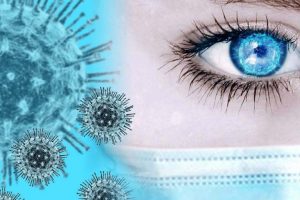The transmission of coronavirus through the mucous membrane of the eye is suggested by many clues. Dr. Jean-Michel Wendling, a specialist in occupational health prevention in Strasbourg, France, gives some ideas for reflection and prevention. Interview.

Dr. WENDLING, in the context of your research on the face shield, do you think that the eye is a possible route of penetration for Sars-coV-2?
Yes absolutely, the saliva contained in the mouth and the sputum projected by a patient when speaking or singing is very rich in live viruses (about 3 x 106 copies per milliliter)(1). The mucous membrane of the eyes and the nose (nasopharynx where the virus nests) are connected by the nasolacrimal duct. When sputum reaches the eye, it mixes with tears and can anatomically pass through this channel into the nasal cavity and be carried to the nasopharynx, the trachea and then the mucous membrane of the respiratory tract or be swallowed through the digestive tract. There is a major risk if an individual spits in another person’s face, which has already been seen, for example, in incivilities towards law enforcement officers or emergency nurses!
Apart from the projection of spittle, is there another source of risk?
Yes, the gesture of “dirty hands or fingers to the eye” is theoretically at risk of transferring the virus. This is all the more so since SARS-CoV-2 persists much longer on the skin and hands (about 9 hours) than other viruses such as influenza (1.8 hours) (2) and the bio-persistence on inert surfaces such as plastic can be very long (5 days), the live virus is found on multiple surfaces in the patients’ environment (bedside table, door handles, switches….).
On average, people involuntarily touch their face and eyes about 10 times/hour (3). This gesture is frequent when working on a computer, blink less often and they end up drying out and stinging.
For example, glasses or face shields may help prevent VIDOC-19 infection by preventing these risky actions and by reminding people that handwashing is essential before touching their eyes, thus preventing the transfer of the virus from hands to eyes through contact.

Have clinical manifestations attributed to COVID ever been identified at the eye level in patients?
Yes absolutely, although rare, various ocular manifestations have been observed. Of a series of 535 patients in one hospital, 20.9% had dry eye, 12.7% blurred vision, 11.8% foreign body sensation and 5% had true conjunctivitis (as the first symptom). In addition, of the 27 patients with conjunctivitis, 70.4% recalled having had hand-eye contact. The analysis also showed that high frequency hand-eye contact was statistically correlated with conjunctival congestion, suggesting that it is a risk factor.
Has the virus ever been found in eye swabs?
In a small series of 41 patients, three tear samples (7%) were positive for SARS-CoV-2. Only one patient had conjunctivitis. All patients with positive tear RT-PCR results had positive nasopharyngeal RT-PCR results. The authors of this study stated that ocular transmission should be considered even in the absence of ocular manifestations.5
Do the cells of the eye possess the famous ACE2 receptors, cellular proteins essential for the virus to enter the body and infect its host?
Absolutely, Dr. MA D. of Shantou University and his colleagues at the Hong Kong Ophthalmological Research Center discovered that in eye tissue samples, this ACE2 protein was found in the conjunctiva, and especially the cornea. The authors suggest that cells on the ocular surface, including the conjunctiva, are susceptible to SARS CoV-2 infection and could therefore serve as a gateway for the virus. The authors emphasized the importance of eye protection in preventing the spread of COVID-19 disease. (6)
Is there evidence that the use of glasses or face shields provides a benefit to groups of individuals?
Yes, certain indicators allow us to think so. Glasses or face shields protect the eyes from various viruses. The benefit of eye protection has been suggested in the context of highly contagious Respiratory Syncytial Virus (RSV) in patients and pediatric staff. During a community RSV epidemic in 1984, the use of eyeglasses resulted in a very significant decrease in RSV infections: 34% of unprotected staff were infected while 5% of protected staff were affected. 43% of infants without eye protection were infected while only 6% of children wearing eyeglasses became infected with RSV, in both cases nearly 7 times less.(7)
In addition, a meta-analysis (synthesis of 15 studies) on coronavirus transmission found that the use of eye protection (face shields, visors or goggles) was associated with a 3-fold lower risk of infection: 16% without eye protection versus 5.5% with eye protection (n=3713, RR = 0.34). In the two adjusted studies (which take into account the other parameters) the risk reduction was even greater with a 78% risk reduction (aOR = 0.22). The authors noted that “eye protection could lead to a strong reduction in viral infection”.
Finally, more recently, a study of patients with COVID-19 in a Hubei hospital revealed that eyeglass wearers represented only 5.8% of patients (16 out of 276 patients) while the percentage of eyeglass wearers in the general population is estimated at 31.5% (wearing at least 8 hours a day). This suggests that eyeglass wearers could be protected from COVID-19. (8) This observational study, although limited by the number of patients, needs to be confirmed by studies involving a larger number of patients or, for example, on the impact of using a face shield.
What do you deduce from this?
The eyes could ultimately be a neglected pathway of entry for SARS-Cov-2.
All this needs to be taken into consideration and direct prevention messages to emphasize hand washing especially after going to the bathroom (the virus is in the stool).
According to a study by Public Health France (5017 people interviewed) conducted in 2016, 21% of French people said they did not systematically wash their hands after going to the toilet, i.e. 14 million people if we extrapolate the surveyed panel to the whole of France .
One can also imagine that a face shield with sufficient coverage, above the forehead, protruding beyond the chin, well worn at a re-entrant angle, as an alternative to the mask, is an option offered more widely because it combines protection for the eyes, mouth and nose. Its superiority in protecting others from sprays but also from aerosols (0.3 micron particles) is also suggested by 2 pre-published studies comparing surgical mask and face shield (Israel Biology Research Institute (9) and School of Engineering – University of Edinburgh (10).
The health departments of Singapore, Oregon (OHA), Pennsylvania and North Carolina have integrated it into their arsenal of population protection (face covering).
The visor is currently a possible alternative in France (under company conditions), in case of disability such as deafness requiring lip reading or in case of medical contraindications to wearing the mask. (11)
NOTES
1 Kelvin Kai-Wang To : Consistent Detection of 2019 Novel Coronavirus in Saliva. Clin Infect Dis. 2020 Feb 12 : Doi: 10.1093/cid/ciaa149 : https://www.ncbi.nlm.nih.gov/pmc/articles/PMC7108139/
2 Ryohei Hirose : Survival of SARS-CoV-2 and influenza virus on the human skin: Importance of hand hygiene in COVID-19 Clinical Infectious Diseases, 03 October 2020; https://doi.org/10.1093/cid/ciaa1517
3 Kwok YL : Face touching: a frequent habit that has implications for hand hygiene. Am J Infect Control. 2015;43(2):112-114. Doi:10.1016/j.ajic.2014.10.015
4 Chu DK, Akl EA, Duda S, et al. : Physical distancing, face masks, and eye protection to prevent person-to-person transmission of SARS-CoV-2 and COVID-19: a systematic review and meta-analysis. Lancet Lond Engl. Published online June 1, 2020. doi:10.1016/S0140-6736(20)31142-9
5 Karimi S, Arabi A, Shahraki T, Safi S. Detection of severe acute respiratory syndrome Coronavirus-2 in the tears of patients with Coronavirus disease 2019. Eye (Lond). 2020 Jul;34(7):1220-1223. Doi: 10.1038/s41433-020-0965-2. Epub 2020 May 18.
6 Ma D, Chen CB, Jhanji V, et al. Expression of SARS-CoV-2 receptor ACE2 and TMPRSS2 in human primary conjunctival and pterygium cell lines and in mouse cornea. Eye (Lond). 2020;34(7):1212-1219. doi:10.1038/s41433-020-0939-4
7 Gala CL : The use of eye‐nose goggles to control nosocomial respiratory syncytial virus infection. JAMA. 1986; 256 (19): 2706-2708. doi: 10.1001 / jama.1986.03380190076028
8 Zeng W, Wang X, Li J, et al. Association of Daily Wear of Eyeglasses With Susceptibility to Coronavirus Disease 2019 Infection. JAMA Ophthalmol. Published online September 16, 2020. Doi:10.1001/jamaophthalmol.2020.3906
9 Ronen A, Rotter H, Elisha S, et al. Examining the protection efficacy of face shields against cough aerosol droplets using water sensitive papers. medRxiv. Published online July 7, 2020:2020.07.06.20147090. doi:10.1101/2020.07.06.20147090
10 Viola IM, Peterson B, Pisetta G, et al. Face Coverings, Aerosol Dispersion and Mitigation of Virus Transmission Risk. ArXiv200510720 Phys. Published online May 19, 2020. Accessed October 10, 2020. http://arxiv.org/abs/2005.10720

